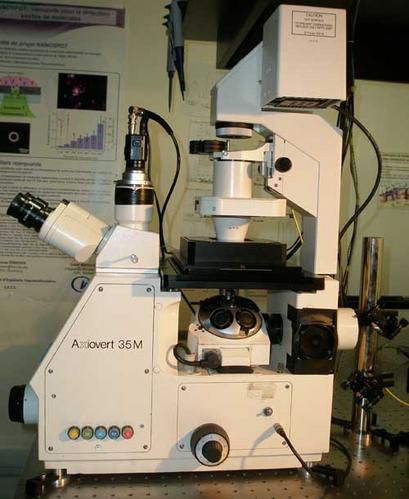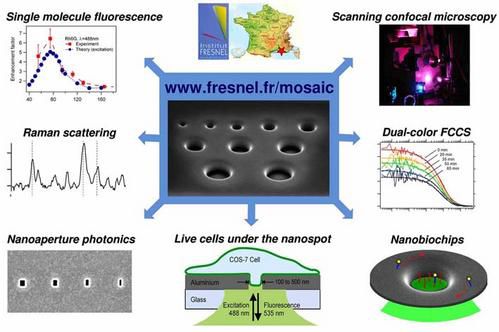Microscope Setup Views
Maybe one of the most crucial part, which will never be published in a paper ! The main picture shows the microscope at the left, the lasers at the center back, and the confocal detection at the forefront right. There are many optical parts, each has a specific role and is manually assembled and aligned.

The second picture focuses on our Zeiss axiovert 35M (inverted) microscope. I should at some time describe it into more details, maybe on a microscope enthusiasts website (micscape).

And finally the microscope objective, which is by far the central component of the setup. We’re using a Zeiss C-Apochromat with 40x magnification, 1.2 numerical aperture, water immersion, coverslip thickness compensation collar and infinite correction. I’m pretty pleased with it for single-color confocal microscopy close to the diffraction limit, but care must be taken to compensate for chromatic aberrations.

Arjeplog Lapland
To brighten the scope of this blog, here is a new category about various fancy things and thoughts.

Introducing Nanoapertures
My present research is focused on the implementation of nanometric structures to enhance the contrasts (fluorescence, Raman) in optical microscopy. Two goals are aimed:
1- Fundamental Nanophotonics : understand the influence of nanometric structures on the optical emission.
2- Applied Biophotonics : use the nanodevices to improve existing biophotonic techniques (confocal microscopy, fluorescence correlation spectroscopy FCS, fluorescence resonance energy transfer FRET)
I’m presently studying the implementation of single apertures milled in an opaque metallic film. These apertures have dimensions below the optical wavelength (range 100-500 nanometers, which is 100 times smaller than a hair diameter).
We see two funny physical effects :
1- The apertures confine the light to volumes in the attoliter range (10^-18L, or 0.001 micron cube)
2- The fluorescence brightness can be enhanced up to 15 fold : we collect 15 times more photons per single molecule inside the aperture (as compared to a conventional solution).
>>> More information on the MOSAIC website.

PhD Thesis Quantum Optics
This work aims at exploiting the quantum properties of light in order to develop new communication devices. The study is devoted to the quadrature components (quantum continuous variables) of a single mode of the electromagnetic field in the pulsed regime. A quantum key distribution protocol using coherent states has been demonstrated, and opens the way for practical high-rate quantum cryptography devices.
In order to study the use of quantum specificities such as squeezing and entanglement, we have developed a new source of pulsed squeezed states and entangled states. This source is based on the nonlinear conversions of ultrashort pulses. We also describe the first observation of a degaussification protocol, that maps individual pulses of squeezed vacuum onto non-Gaussian states. Finally, we study some optical set-ups allowing for a loophole-free Bell test using continuous variables and efficient homodyne detections.
Keywords
Quantum information - quantum communication - quantum cryptography - continuous variables - pulsed homodyne detection - femtosecond pulses - parametric amplification - squeezed states - non-Gaussian states - entanglement - Bell's inequalities



